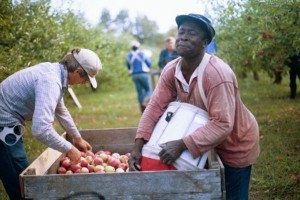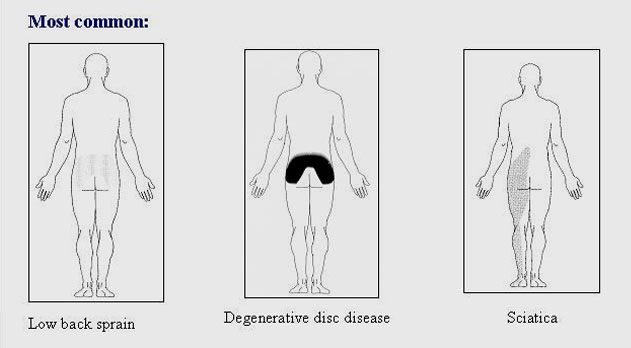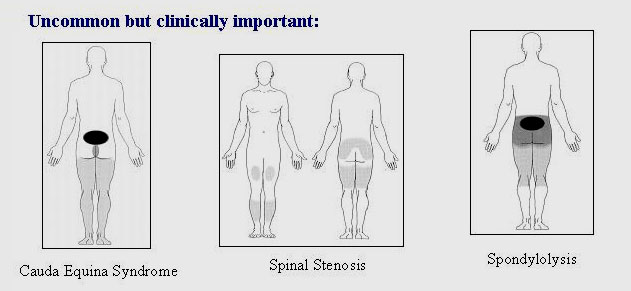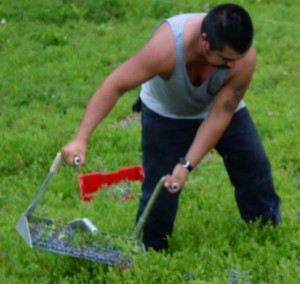Farmworker low back pain: contributing factors
One farmworker study found the prevalence of chronic back pain ranged from 9.5-33.3%. Variables significantly associated with chronic back pain:
- Working tree crops (OR, 11.72).
- Depressive symptoms while migrating (OR, 8.72),
- Fairly bad/very bad quality of sleep while migrating (OR, 3.25),
Among adolescents in this study group, increased adjusted odds ratios for severe back pain were:
- Prior accident/back injury (9.04);
- 6+ years involved in migrant farm work (5.02);
- Female sex (4.59);
- Feeling tense, stressed, or anxious sometimes/often (4.11);
- Lifting/carrying heavy objects not at work (2.98);
- Current tobacco use (2.79);
- Working with/around knives (3.87);
- Working on corn crops (3.40).
Typical anatomical patterns of low back pain
Low back pain – medical definitions
Acute Low Back Pain (Low back strain or sprain, “pulled muscle”, mechanical LBP)
- Most common form
- Risk factors include: repetitive bending, twisting and lifting; heavy lifting; whole-body vibration; sustained awkward posture; smoking; poor fitness.
- May occur without any history of injury or overuse.
- 85% resolve within 4 weeks regardless of treatment
Acute lumbar disc herniation
- Risk factors include extreme lifting, age >50 years
- 10-25% have persistent sciatica at 6 weeks,
- 80-90% resolve without surgery
Degenerative disease
- Osteoarthritis (DJD)
- Degenerative disc disease
- Spinal stenosis
- Ankylosing spondylitis
- All more likely after age 50
- Chronic pain
Traumatic
- Compression fracture (increased risk with osteoporosis, age >70)
- Spondylolysis/spondylolisthesis
Medical
- Infection (paraspinous abscess, pyelonephritis, gyn infections)
- Nephrolithiasis
- Metastatic disease
Michael Rowland, MD, Syracuse Occupational Health Clinic
Low back pain – farmworker definitions
Farmworkers are here to work – their employability may be tied to their fitness – light duty might be viewed as unacceptable
Different cultures may define pain differently. For example, a study in California (Faucett et al. 2001), found that Mexican workers define PAIN as something that prevents you from working. They defined the pain they associated with farm work as DISCOMFORT (molestias). Therefore a working farmworker would say that he has no pain, even if he is experiencing what is considered pain in the U.S.
Farmworkers may have difficulty accepting light duty or other treatment recommendations for pain if they experience pain so often that it is considered part of the job (cite)
Low back pain – diagnostic tools
Diagnosis
The great majority of patients presenting with acute low back pain require only rest, time, and OTC pain medications. It is essential, however, to detect those few with more serious disease who will require more intensive workup and referral. Skillful use of the history and physical exam will allow the medical provider to safely accomplish this winnowing process. The AHCPR guidelines are a systematic, evidence-based approach to this (algorithm next page).
Special considerations regarding migrant farmworkers and low back pain:
Risk factors
- Work is back-intensive: frequent bending, twisting, lifting, long hours, piece work.
Protective factors
- Healthy worker effect: H2A physicals and migration select for younger, fitter population.
- Low smoking rate, especially among Hispanic workers.
- Less likely to adopt behaviors associated with chronic pain and disability, such as prolonged bed rest and injury litigation.
Acute low back pain problems in adults:
Assessment and Treatment
Quick Reference Guide for Clinicans
Clinical Practice Guideline #14
U.S. Agency for Health Care Policy and Research
Enter Module Here
Question:
Is there a way to incorporate this entire module into our website, so you can go to it and still be in our website? (I assume we need to get permission to do this?)
Initial assessment of acute low back symptoms*
Algorithms
- Initial evaluation of acute low back problem
- Treatment of acute low back problem on initial and follow-up visits
- Evaluation of the slow-to-recover patient (symptoms > 4 weeks)
- Surgical considerations for patients with persistent sciatica
- Further management of acute low back problem
- Summary of AHCPR Guideline Recommendations
The information in this booklet was based on the Clinical Practice Guideline, Acute Low Back Problems in Adults. The Guideline was developed by a non-Federal panel of experts sponsored by the Agency for Health Care Policy and Research. Other guidelines on common health problems are available, and more are being developed.
For more information about guidelines or to receive a free printed copy of Acute Low Back Problems in Adults: Assessment and Treatment, call toll-free 800-358-9295, or write to:
Agency for Health Care Policy and Research
Publications Clearinghouse
P.O. Box 8547
Silver Spring, MD 20907
The Guideline Technical Report contains complete supporting materials for the Clinical Practice Guideline, including background information, methodology, literature review, scientific evidence tables, recommendations for research, and a comprehensive bibliography. It is available from the National Technical Information Service, 5285 Port Royal Road, Springfield, VA 22161. Call (703) 487-4650 for price and ordering information.
Light Duty: Only recommend when available and appropriate
Shelley Davis, Farmworker Justice, Mike Rowland, MD, MPH, Maine Migrant Health Program and Rafael Albarran, TheWatsonville Law Center. MCN Streamline, vol 13 July/August, 2011
- Determining when to recommend that a farmworker return to work after an employment-related injury is one of the challenging decisions a clinician must make in a workers compensation case.
- To accommodate a return to work request when healing is not yet complete, the clinician may choose the middle ground of prescribing a return to “light duty.” Strategic use of light duty is a standard practice across all industries, and is based on good data that, when properly done, it results in faster recovery, less long-term disability, and lower costs. This is especially true in the case of low back pain, the single most common and costly work injury.
- While light duty can be a reasonable option in some instances, it is important to recognize that in many agricultural workplaces, light duty jobs do not exist.
- Additionally, clinicians cannot assume that workers will have workers compensation coverage. In these cases, the worker and provider have less leverage, and light duty may not be made available at all.
- To avoid these pitfalls, a clinician should consult the patient to determine the degree of recovery, including on-going pain and perceived ability to return to work. In addition, the clinician should inquire into the physical demands of the job and ascertain whether any light duty jobs exist at that establishment.
If light duty is available and appears appropriate, the clinician should specify the conditions under which such duty may be performed, e.g., amount of weight which can be lifted, number of hours that the worker can stand, whether work can be performed in a stooped position, etc. Finally, the clinician should advise the worker to return to the clinic if injury prevents her from performing light duty.
Recommended light duty parameters*
| Symptoms | Moderate / Severe | Mild | None |
|---|---|---|---|
| Lifting restriction | 20lbs | 60# (M), 35# (F) | 80# (M), 40# (F) |
| Bend / Twist | Minimal | Limited | — |
| Sitting | 20 min | 50 min | — |
*Essentials of Musculoskeletal Care. Walter Green, editor. American Academy of Orthopedic Surgeons, 2001.check reference
More information on low back pain
Alternative initial evaluation algorithms:
- Institute for Clinical Systems Improvement (ICI) Adult Low Back Pain algorithm (algorithm, page 2)
- American College of Physicians and the American Pain Society Diagnosis and treatment of low back pain: A joint clinical practice guideline
- UpToDate@ 2012, Diagnostic algorithm of low back pain
- General low back pain diagnosis guidance at UpToDate@ 2012




 Low Back Pain
Low Back Pain Shoulder Strain
Shoulder Strain